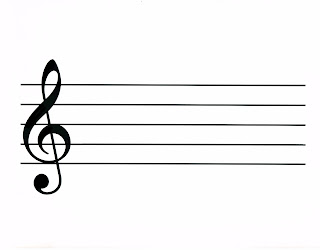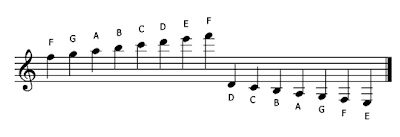I love these five notes. They have such a melancholy air about them. I could play them over & over again. And I do quite often. You should too! Once you've become proficient at playing the exercise, try to increase your speed. But be sure to pick every note! No cheating with pull-offs or hammer-ons! Those will come later. For the moment, it will only help you to pick every note. Up-down-up-down. Do the same when strumming chords.
And say, do you realize how many chords you know already? You've learned C, A, G, E & D as well as Am, Dm & Em. With eight chords at your disposal, you could be writing hit songs right now! Let's put some of these chords together & see what we can come up with. Try these chord progressions:
Notice that the tablature has changed. You know how to play these chords, so you don't need the tab. The slashes simply mark the beat where the chords are played. Play through each exercise slowly. They're all in 4/4 time. But there are a lot of eighth notes & rests. So count to yourself "1 and 2 and 3 and 4 and" as you play. Look at the rests. They tell you where not to play.
For example, in study #1, you don't play on beat 2 or beat 4 in the 1st measure. Those are quarter note rests. So they each get 1 beat of silence. And the same is true of the 3rd measure. Similarly, the 2nd & 4th measures both play the same syncopated pattern. The D chord is played on the "and" after beat 2. The rest before it is an eighth note rest. It gets half a beat, which happens only when the beat hits "2" in our counting pattern. Then you play on "and". After beat 4, you rest on "and" before starting the next measure. It's a repeating pattern. So every other measure copies itself in an alternating sequence. See? Pretty cool sounding huh?
All three exercises are loosely based on the verse patterns from actual songs. See if you can figure out the title of each. Don't get discouraged. Play slowly & if that isn't slow enough, then slow it down some more. The beats per minute, shown as a number after the 1/4 note "=" above the 1st measure, are there to give you a guideline as to the tempo. But you don't have to start there of course. Play as slowly as you like. No one is watching you rehearse yet, most likely. And the important thing is to get the pattern right. Not how fast you can play it! Speed will come soon enough, I promise you.
The next two exercises should be played in the same slow, counting-while-playing fashion. Watch the rests! And pay attention to what is happening around the 2nd & 4th beats. That usually where the action is in popular music. You'll be rocking through all three of them in no time! And I'll be back soon with some notes on the 5th & 6th strings and even more chord progressions. Rock on!













